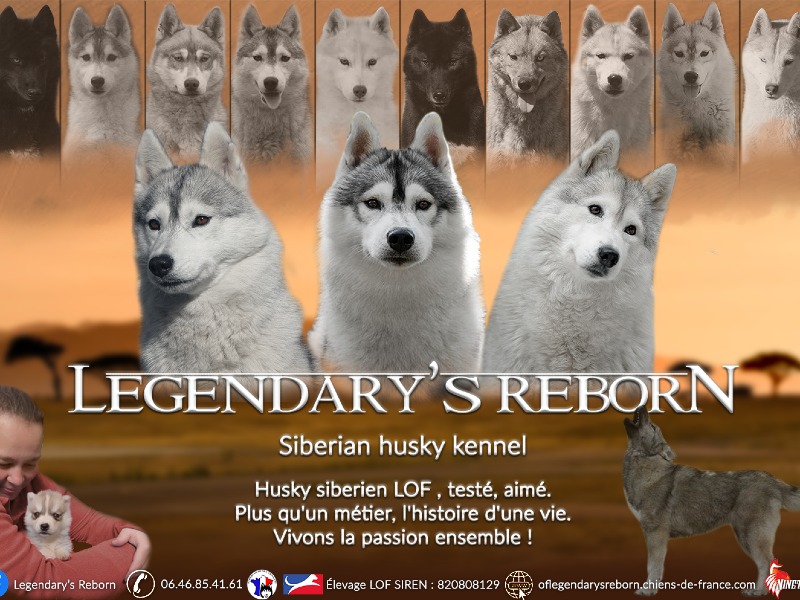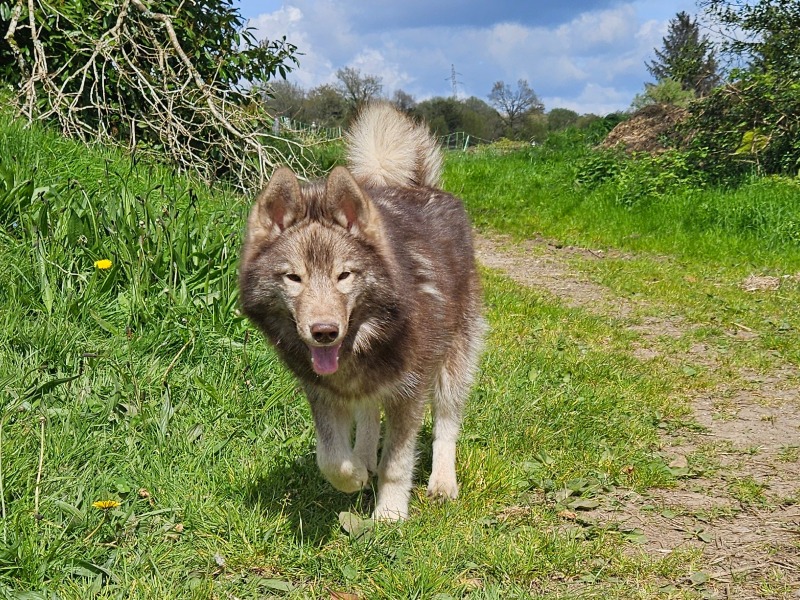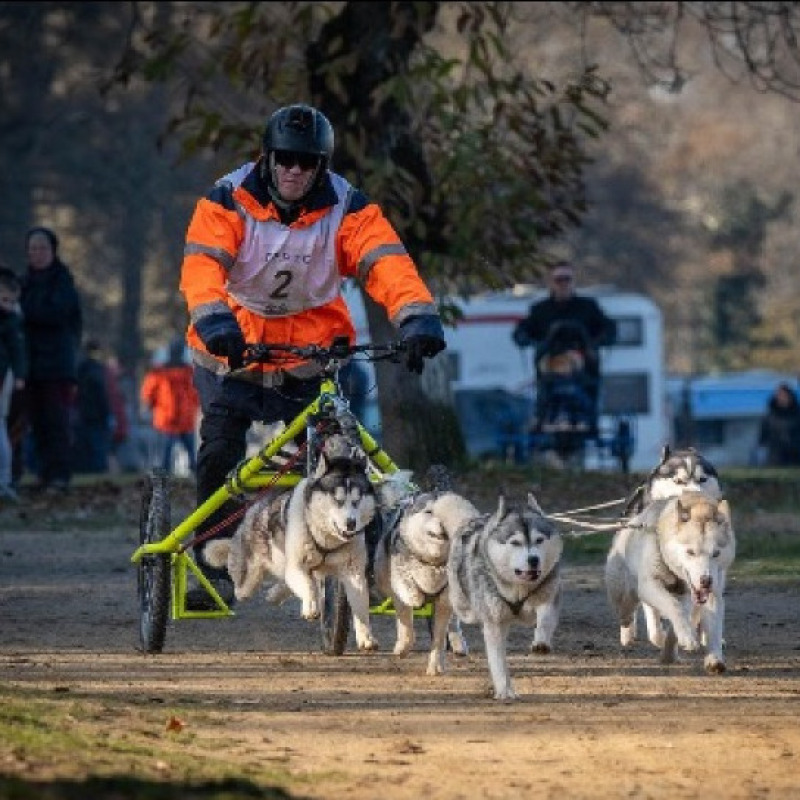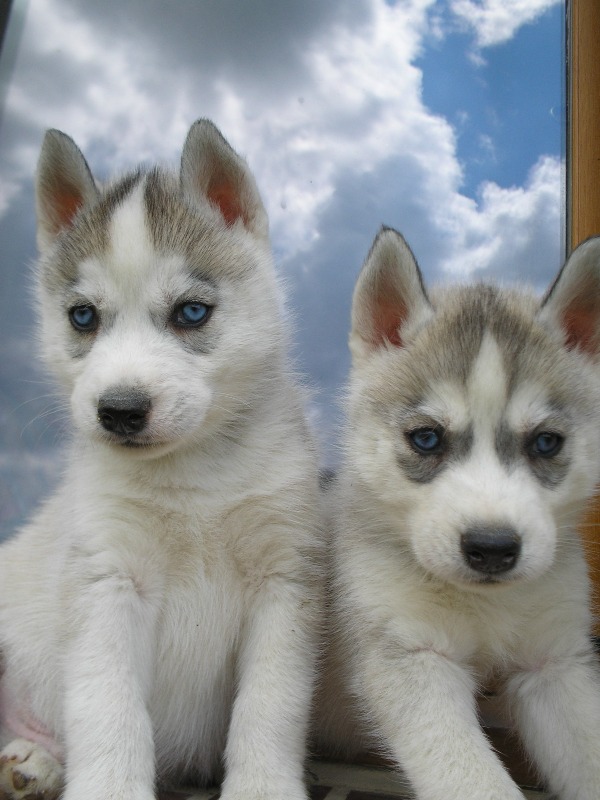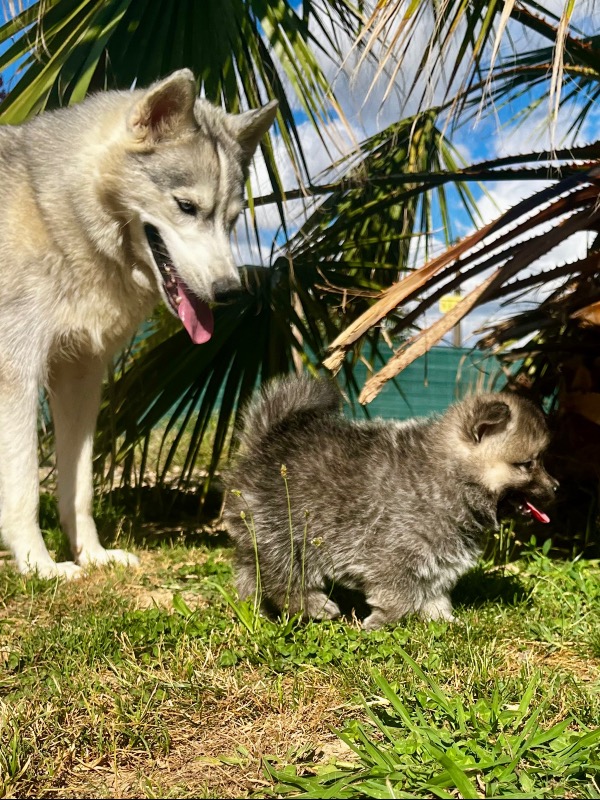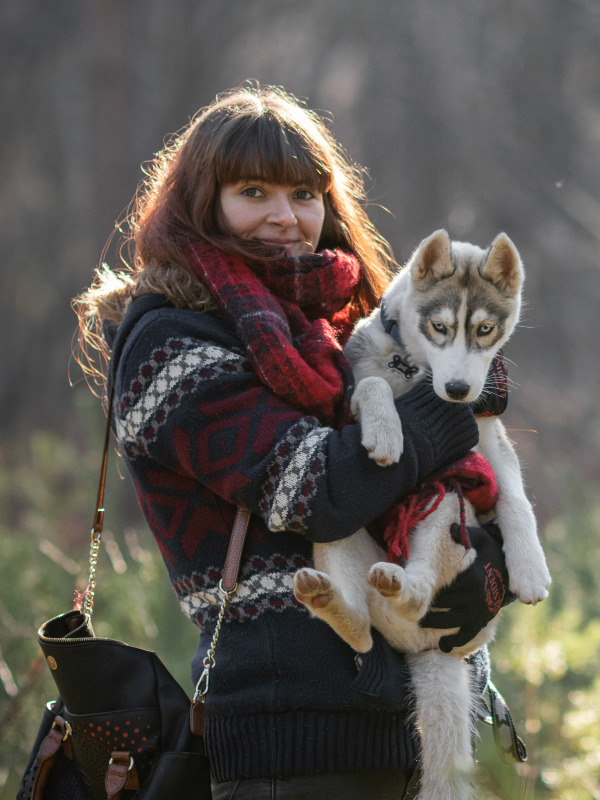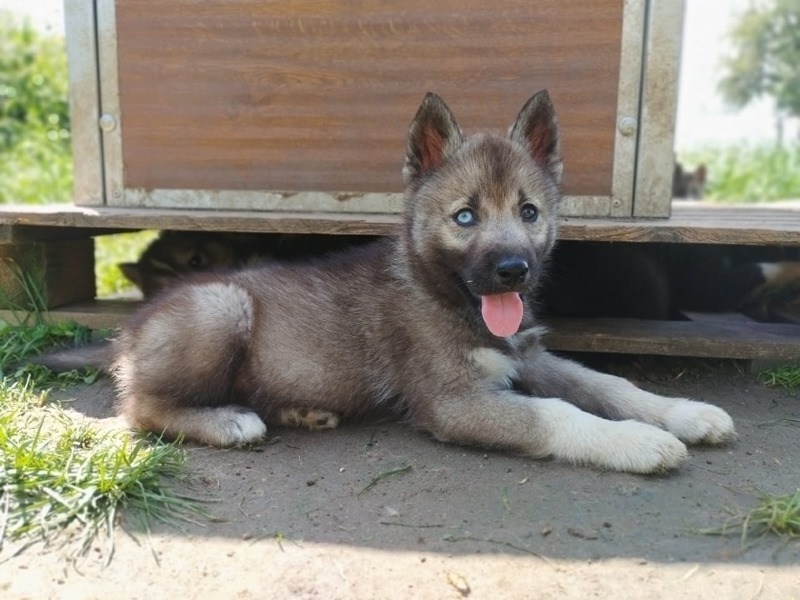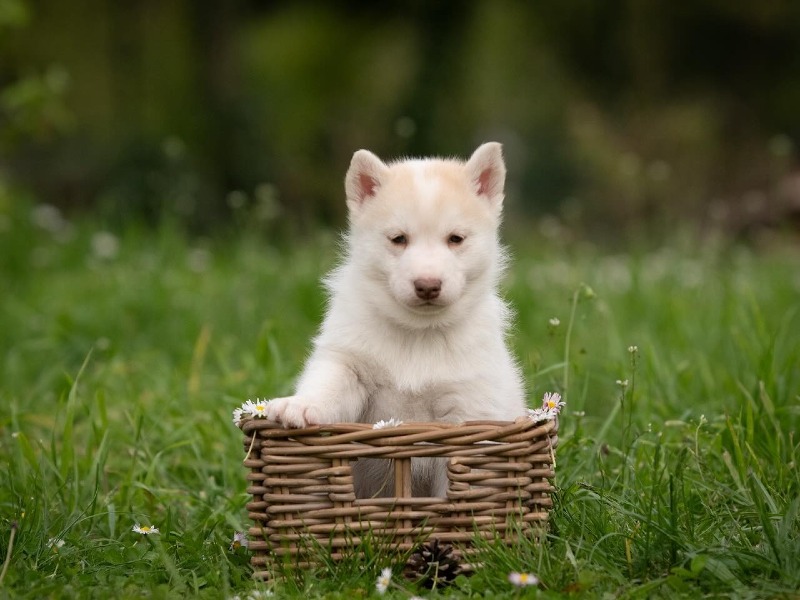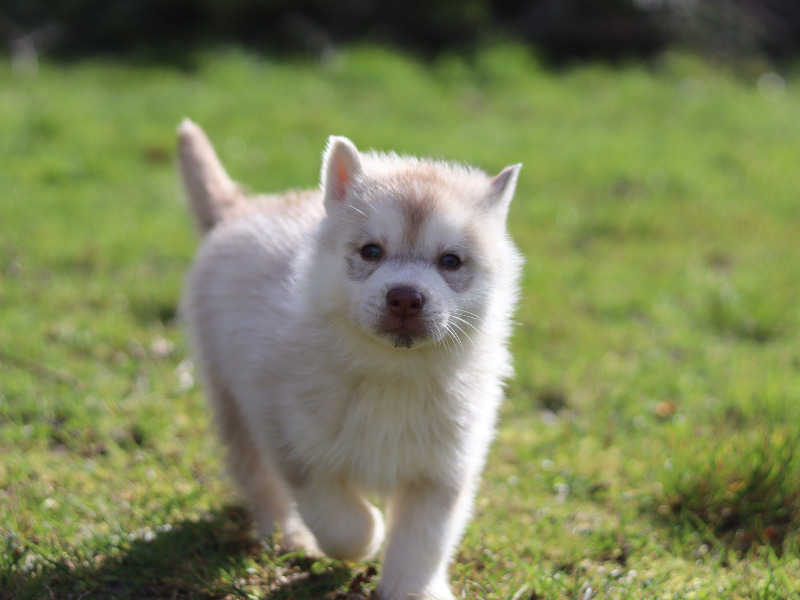Siberian husky
Welcome to our page dedicated to the breed of dog siberian husky!
Here, you will find all the useful information about siberian husky. This descriptive profile will allow you to discover the aspects of this breed. You can notably consult information about the average price, monthly and annual upkeep expenses, their health, name ideas, as well as their official recognition by competent authorities.
Explore this page to discover everything you need to know.
Overall description of the breed
The Siberian Husky, as its name suggests, is native to Russia and more precisely to the great Siberian plains, a region of the world where living conditions are extreme. Legend has it that the Husky is the result of a cross between a wolf and the moon, which is why he looks like a wild wolf and has a whip in the shape of a crescent moon. The Husky is a very old breed, dating back to nearly 2000 years BC, which appeared in Eastern Siberia with the Choukchis, a nomadic Eskimo people, who used it as a guard dog or sled dog, which allowed them to move more easily through the immense snowy territories. Their draconian selection method made it possible to create a balanced, sporty and non-aggressive breed, which corresponded perfectly to a simple way of life, close to nature.
Later, at the beginning of the 20th century, the commercial links between Russia and the United States allowed the first Husky subjects to be imported into the USA. The American breeder, Eva Seeley, developed the breed throughout America and helped emancipate it throughout the West. Recognized by the AKC (American Kennel Club) as early as 1930, it was officially registered by the Fédération Cynologique Internationale on September 8, 1966, and its current standard was published on November 14, 2022.
The Siberian Husky is a medium-sized dog, homogeneous and particularly robust. With a natural elegance, it is a dog with a dignified and proud appearance, with pure and refined lines. His mischievous look suggests his great intellectual abilities. He is a determined, enduring and muscular dog, with exceptional resistance to effort. He is very much appreciated for his marathon qualities, he can run up to 130 km every day. His limbs are powerful, agile and vigorous, his topline is straight, broad, fairly short and slightly curved at the loins, his head is round, his muzzle long and pointed, his round-tipped ears are well set on top of his skull. They have a thick coat with a thick undercoat, which gives them excellent protection against the cold. The coat colours permitted by the breed standard are black, grey, white, sandy and, in some cases, a special facial marking which characterises the breed.
As for its character, the Husky is known to be very attached to its social group and very tender with its family, but what it likes above all is its freedom. This need is inscribed in his DNA, life in a flat does not suit him at all and he prefers the great outdoors in the countryside rather than evolving in an urban environment. His energy is overflowing and his primitive instinct is clearly pronounced, he will tend to run away if his daily needs are not met. It is an excellent family dog, close and protective towards children, on the other hand education is not its strong point, it will always tend to think before carrying out an order stupidly, with a Siberian Husky, nothing is ever acquired for ever! Great predator and endowed with an incredible sense of smell, the slightest lead can take him on a journey of several hours, walks in total freedom can be complicated if he spots an attractive smell. Mutual trust and patience are really the keys to success with the Siberian Husky, independent and autonomous by nature, he will nevertheless show you his unconditional love!
Adult: The Siberian Husky will weigh between 44 to 61.7 lbs for the male and 33 to 50.7 lbs for the female, its height at the withers will be between 21.2" to 23.6" for the males and 19.6" to 22" for the females
Awareness of acquiring an animal
Each animal is a sensitive being, deserving love, attention and care.
When you choose to adopt an animal, you take on the responsibility of ensuring its health and well-being throughout its life.
To learn more about animal welfare, we invite you to consult our FAQ by clicking the button below:
Origins
The Siberian Husky originates from Siberia, where it was bred by the Chukchi people to pull sleds over long distances. This robust dog is the result of centuries of selection to create an animal capable of withstanding extreme weather conditions. Its endurance, strength, and ability to work as a team make it an ideal companion for demanding tasks in harsh environments. The Chukchi people particularly appreciated these dogs for their hunting and herding abilities. With the arrival of Russian settlers and later European explorers, the Siberian Husky began to gain popularity outside of its original lands, thanks to its exceptional qualities.
History
The history of the Siberian husky is closely linked to the nomadic peoples of Siberia. Used primarily for transportation and hunting, these dogs were essential to the survival of the Chukchi tribes. In the early 20th century, huskies were introduced to North America, particularly in Alaska, where they quickly gained fame through sled dog races. One of the most famous stories is the 1925 serum run to Nome, where a team of huskies braved extreme conditions to deliver vital medicines, saving many lives. This heroic adventure solidified the reputation of the Siberian husky as an incredibly resilient and reliable dog.
Standard
The Siberian Husky is a medium-sized dog, well-proportioned and with an elegant appearance. According to the standards of the International Canine Federation (FCI), males measure between 53 and 60 cm at the withers and weigh between 20 and 27 kg, while females measure between 50 and 56 cm and weigh between 16 and 23 kg. Their overall appearance should be both powerful and agile, reflecting their ability to work with endurance. The eyes, often blue, brown or multi-colored, are almond-shaped and slightly slanted, adding to their lively and friendly expression. The ears are medium-sized, triangular and erect. Their tail, shaped like a sickle, is carried above the back in a graceful curve.
Physical characteristics
The Siberian Husky is a medium-sized dog, with males measuring between 53 and 60 cm at the withers and weighing between 20 and 27 kg. Females are slightly smaller, measuring between 50 and 56 cm and weighing between 16 and 23 kg. Their double coat is thick and dense, designed to protect them from the Siberian cold. The undercoat is soft and dense, while the topcoat is straight and of medium length. The coat colors vary, including black, gray, red, sand, and white, often with distinctive markings on the head. The almond-shaped eyes can be blue, brown, or two different colors, giving the husky a piercing and expressive look.
Character
The Siberian Husky is known for its friendly, energetic, and independent temperament. This dog is extremely social and loves the company of people and other dogs. Although affectionate, it is not excessively dependent and can sometimes show some independence. The Siberian Husky is also known for its intelligence and curiosity, making it both fascinating and sometimes a bit stubborn. It needs a lot of exercise to channel its boundless energy. Despite its wolf-like appearance, the Siberian Husky is generally very gentle and not inclined to aggression, making it an excellent family companion.
Life expectancy
The Siberian Husky generally enjoys good health and a long lifespan for a dog of its size. On average, a Siberian Husky lives between 12 and 15 years. This longevity is partly due to strict breeding and the inherent robustness of the breed. However, to ensure a long and healthy life, it is essential to provide these dogs with balanced nutrition, regular exercise, and appropriate veterinary care. Like all breeds, the Siberian Husky can be prone to certain genetic conditions, but with proper care and constant vigilance, these dogs can lead a long and active life.
Exercise and activity needs
The Siberian husky is an extremely active breed that requires a lot of exercise to stay healthy and happy. They need at least one to two hours of intense physical activity each day. Ideal activities include running, jogging, long walks, and interactive games. Due to their history as sled dogs, they excel in canine sports such as canicross, skijoring, and of course, mushing. A Siberian husky that does not receive enough exercise can become bored and destructive, seeking to release pent-up energy inappropriately. Their constant need for mental and physical stimulation must be taken into account for their overall well-being.
Recommended diet
The diet of a Siberian Husky must be balanced and of high quality to meet its high energy needs. Premium quality dry food, combined with meat and vegetable supplements, is recommended. An adult Husky typically consumes between 250 and 400 grams of food per day, divided into two meals. The monthly cost of feeding a Siberian Husky can range between 50 and 100 euros, depending on the quality of food chosen. It is essential to monitor their weight and adjust their diet according to their activity level, to avoid problems of overweight or nutritional deficiencies.
Training and obedience
The education and training of a Siberian Husky require patience, consistency, and a good dose of positivity. Due to their intelligent yet independent nature, these dogs can be somewhat stubborn. It is important to start training at a young age, using positive reinforcement methods such as rewards and praise. Training sessions should be short and varied to maintain their interest. Early socialization is also crucial to help them get along with other dogs and people. A well-trained husky can become an obedient and enjoyable companion, but be prepared to invest time and effort to achieve this.
Behavior with children
The Siberian Husky is generally very good with children. Its friendly, playful, and tolerant temperament makes it an excellent companion for families. Huskies are often very protective of younger family members and enjoy participating in games and activities. However, due to their boundless energy, it is important to supervise interactions between huskies and young children to avoid unintentional accidents. By educating children on how to treat dogs with respect and gentleness, cohabitation between a Siberian Husky and children can be harmonious and rewarding for all family members.
Compatibility with Other Animals
The Siberian Husky is generally sociable and can get along with other pets if properly socialized from a young age. However, due to their natural hunting instinct, they may have a tendency to chase small animals such as cats or rodents. It is therefore crucial to monitor initial interactions and to introduce them gradually. Huskies have a strong pack mentality and often get along well with other dogs, especially those of similar size. Proper socialization and attentive supervision are essential to ensure a harmonious cohabitation with other pets.
Grooming needs
The Siberian husky has a thick double coat that requires regular maintenance. Although they are naturally clean and do not require frequent baths, weekly brushing is recommended to remove dead hair and prevent tangles. During shedding periods, which occur twice a year, daily brushing may be necessary to manage abundant hair loss. Regular grooming also helps maintain healthy skin and coat. It is also important to regularly check and clean the ears, trim the nails, and maintain good dental hygiene to ensure the overall health of the dog.
Health
The Siberian Husky is generally a robust and healthy breed, but it can be prone to certain genetic conditions. Common health problems include hip dysplasia, cataracts, and other eye issues such as progressive retinal atrophy. It is important to choose a responsible breeder who conducts health tests on the breeding dogs to minimize these risks. Regular veterinary visits, vaccinations, and preventive care are essential to maintain the health of the Siberian Husky. A balanced diet and adequate exercise also help prevent health problems related to weight and metabolism.
Average price
The price of a Siberian Husky varies depending on several factors such as the breeder's reputation, the parents' lineage, and the region. Generally, the cost of purchasing a Siberian Husky puppy ranges from 800 to 1500 euros. For dogs with champion lineage or exceptional breeding qualities, the price can be higher, sometimes reaching up to 2000 euros or more. It is important to inquire about the breeders and check the conditions in which the puppies are raised to ensure their health and well-being before making a purchase.
Expenses
In addition to the initial purchase cost, monthly expenses for a Siberian Husky can range from 70 to 150 euros. These costs include high-quality food, regular veterinary care, grooming products, and necessary accessories such as collars, leashes, and toys. It is also recommended to have health insurance to cover any unexpected medical expenses. Training and education classes may also incur additional costs, especially during the first year. Planning an adequate budget is essential to ensure that the Siberian Husky receives proper care throughout its life.
Name ideas
Choosing a name for your Siberian husky can be a fun and creative task. Here are some name suggestions that suit their majestic appearance and lively temperament:
Males: Balto, Ghost, Nanook, Thunder, Koda, Atlas, Loki, Hunter, Diesel, Shadow.
Females: Luna, Aurora, Sky, Maya, Saphira, Storm, Nala, Willow, Freya, Misty.
These names reflect both the beauty and strength of the Siberian husky, while being easy to pronounce and recognize for the dog.
Legislation and regulation
In France, the Siberian Husky is not classified as a "dangerous" dog and therefore does not require any specific declaration to the town hall or special insurance beyond civil liability. However, as with all dogs, it is mandatory to respect local regulations regarding leashing in public spaces and parks. Additionally, owners must ensure that their husky is identified by microchip or tattoo, and that he receives the required vaccinations. It is also important to inquire about specific regulations in other countries if you plan to travel with your Siberian Husky.
Official recognition
The Siberian Husky is recognized by many cynological organizations around the world. In France, it is recognized by the Société Centrale Canine (SCC). In the United States, the American Kennel Club (AKC) and in Canada, the Canadian Kennel Club (CKC) also recognize the breed. The Kennel Club in the UK and the Fédération Cynologique Internationale (FCI) have breed standards for the Siberian Husky. This official recognition ensures that huskies are bred according to strict criteria in terms of health, temperament, and physical conformation, thus ensuring the maintenance of the typical characteristics of the breed.
Pedigrees
Siberian Huskies can obtain pedigrees from various breed clubs around the world, ensuring the purity and traceability of their bloodlines. In France, the French Club of Nordic Dogs and Japanese Spitz is a reference for obtaining pedigrees. In the United States, the American Kennel Club (AKC) provides detailed pedigrees. In Canada, the Canadian Kennel Club (CKC) is the responsible organization. The Kennel Club in the United Kingdom and the Fédération Cynologique Internationale (FCI) are also recognized sources for Siberian Husky pedigrees. These clubs also offer valuable information and resources for owners and breeders.
Destination and usage
Historically, the Siberian husky was bred to pull sleds over long distances, a task for which it is still used today in cold regions and for sled races. In addition to this traditional function, the Siberian husky is also an excellent companion dog thanks to its friendly and sociable temperament. It excels in various canine sports such as canicross, skijoring, and agility. Due to its energy and endurance, it is ideal for active families who enjoy outdoor activities. The Siberian husky can also be trained as a therapy dog or search and rescue dog.
Prohibitions
There are no specific prohibitions regarding the possession of Siberian huskies in France or in most countries. However, it is crucial to check local regulations before acquiring a husky, as some municipalities may have restrictions regarding the size or breeds of dogs. Owners must also comply with local laws on leash-walking and areas where dogs are allowed. It is also prohibited to leave a Siberian husky unsupervised in an unfenced area, due to their instinct to run away and hunt. Sterilization may be required in certain situations to prevent uncontrolled breeding.
Breeders of Siberian husky
Want to see more breeders of Siberian husky?
Check out the page of our directory listing all breeders of Siberian huskyClassified Ads of Siberian husky
Breed clubs of siberian husky
No of siberian husky breed clubs are currently registered on Preeders.
If you would like to highlight your breed club, sign up for free now and be the first to appear on this page.

